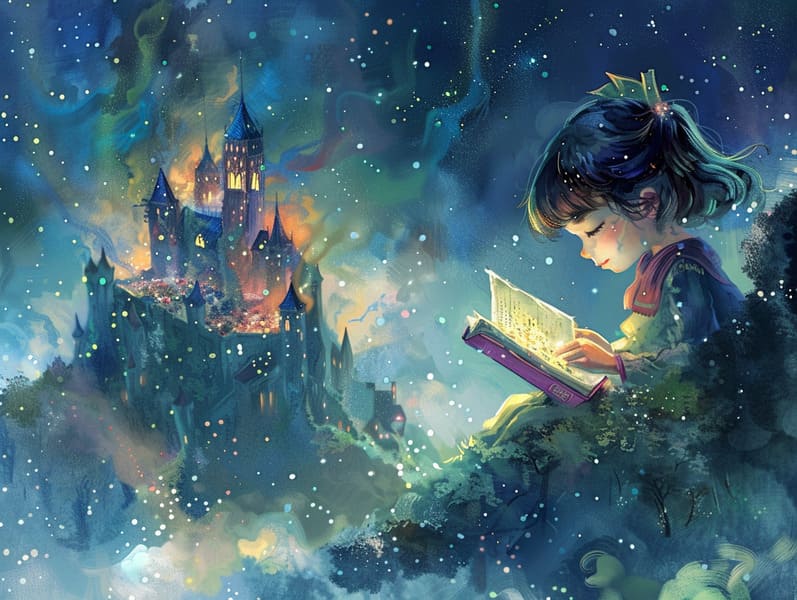
Traditional fairy tales have old origins. These tales have been transmitted from one generation to the next millennia before they were ever recorded. They emerged from a variety of cultures, including Asian traditions. They were initially passed along among adults, often carrying themes and messages aligned with the societal norms and beliefs of the time.
The Grimm brothers, the two Grimm brothers, were among the first to compile many of these beloved tales. Their anthology, "Grimm's Fairy Stories," included stories like "The Little Glass Slipper," "Little Brother and Little Sister," and "Snow-White and Rose-Red," which have since become pillars in the world of famous fairy tales. Similarly, H. C. Andersen's delightful tales, such as "The Mermaid's Tale," and "The Little Duckling," have stolen hearts worldwide, cementing their place in the pantheon of iconic fairy tales.
Though they are old, these tales remain as relevant as ever, especially as bedtime stories for kids. These fantastical tales are now available in different formats, including colorful picture books, enchanting animations, and internet fairy tales.
Their enduring popularity can be traced to several captivating elements:
Crucial Morals: Old fairy tales often share important moral lessons. Fairy tales like "The Boy Who Cried Wolf" teach the virtue of truth, while "The Tale of the Tortoise and the Hare" point out the traits of tenacity and unassuming nature. These stories offer young ones clear distinctions between right and wrong, helping to shape their moral compass in a mild yet profound way.
Empathy and Awareness: Ancient fairy tales frequently showcase figures facing difficulties and adversities, fostering young readers to relate with their struggles and encourage their triumphs. For instance, "Beauty and the Beast" points out the importance of seeing beyond the surface to know the true being of a character, promoting insight and understanding.
Cultural Comprehension: Many ancient fairy tales are rooted in the cultural contexts from which they blossomed. Immersing in these fairy tales can provide illuminating insights into different traditions, strengthening a sense of world awareness and respect.
Creativity and Fantasy: The supernatural elements in classic fairy tales—spells and potions—ignite children’s creativity. These stories carry readers to here supernatural realms, enhancing creative ideas and a sense of marvel that lasts a lifetime.
Classic fairy tales are not only delightful but also illuminating. They serve as alluring tools in building various intellectual and emotional capacities in young ones. When ancient fairy tales are recited, they promote language skills by bringing new phrases and intricate sentence structures. This practice also strengthens listening skills and focus, as the young listen intently, excited to see what happens next.
Furthermore, analyzing the themes and characters of timeless fairy tales can foster cognitive skills and thinking skills. The young learn to spot patterns, anticipate outcomes, and realize cause and effect. These analyses also support young ones reveal their thoughts and feelings, contributing to their emotional intelligence.
In today’s technological age, the abundance of free fairy tales online has made these narratives more within reach than ever. Digital sites and applications offer extensive collections of famous fairy tales that can be browsed or listened to anytime, anywhere. Fairy tales narrated are particularly sought after, making available an enjoyable way for kids to delight in these charming stories. Audio stories and narrated videos move characters and settings to life, often paired with magical background sounds and music that improve the tale journey.
The unfading fascination of traditional fairy tales lies in their ability to alter to modern times while maintaining their core values. Contemporary modernizations of these narratives often show more multicultural protagonists and modern settings, making them relatable to today’s audience. However, the main ideas of valor, empathy, and integrity remain unchanged, continuing to resonate with young readers of all ages.
Traditional fairy tales also offer a sense of ease and homeliness. They impart upon a well-ordered narrative with a transparent beginning, middle, and end, often coming to a close with the conclusion of conflicts and the triumph of truth over falsehood. This assuredness can be comforting for young readers, rendering a sense of reliability in an dynamic world.
Old fairy tales continue to captivate and instruct new generations, maintaining their mystique and applicability in modern society. As nighttime stories for kids, they put forth a perfect blend of fantasy and learning, nourishing moral values, empathy, and creativity. The availability of digital storybooks and the popularity of fairy tales read out loud assure that these timeless tales remain reachable to new generations.
By guarding and distributing these stories, we continue to esteem the rich tapestry of fantasy and cultural heritage. Whether you are delving into a richly illustrated book, perusing a internet library, or playing an voice book, the spell of famous fairy tales is always within reach. These fairy tales point out of the undying power of tales and its ability to unite us across epochs and places.
Even if you are seeing a richly illustrated book, delving into a internet library, or hearing an sound book, the charm of ancient fairy tales is always within reach.
These tales teach us of the consistent presence of fairy tales and its ability to tie us across time and space, forming a connection that fascinates and enlightens alike.